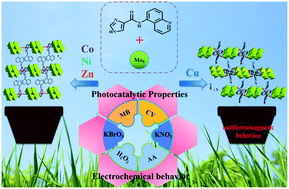Four octamolybdate complexes constructed from a quinoline–imidazole–monoamide ligand: structures and electrochemical, photocatalytic and magnetic properties†
Abstract
By introducing a quinoline–imidazole–monoamide ligand, N-(quinoline-5-yl)-1H-imidazole-4-carboxamide (L), into reaction systems containing a [Mo7O24]6− polyoxoanion and different metal ions, four octamolybdate-based complexes with the general formula of [M(HL)2(β-Mo8O26)] (M = Co (1), Ni (2), and Zn (3)) and [Cu2(HL)2(μ2-OH)2(β-Mo8O26)] (4) have been hydrothermally synthesized. All the complexes are 2D supramolecular structures with 1D chains based on the [β-Mo8O26]4− polyoxoanion. Complexes 1–3 are isostructural with the same architectural feature of a mononuclear [M(HL)2]4+ unit, but a binuclear [Cu2(HL)2(μ2-OH)2]4+ cation in complex 4, manifesting that the metal cation has a marked impact on the structures of 1–4. Meanwhile, the hydrogen bonding interaction between the protonated nitrogen atom of quinoline and the surface oxygen atom of the polyoxoanion demonstrates a crucial role in the formation of the supramolecular structure. All the complexes have better electrocatalytic activities, including not only the reduction properties of inorganic bromate, nitrite and hydrogen peroxide, but also the oxidation properties of ascorbic acid. In particular, 2-CPE can sense bromate and ascorbic acid with low detection limits of 1.67 and 6 μM. Both complexes 1 and 4 possess better photocatalytic properties for degrading organic dyes gentian purple and methylene blue, but only methylene blue for 3, accompanied by a weak antiferromagnetic behavior for complex 4.



 Please wait while we load your content...
Please wait while we load your content...